Are you a Quiet Speculation member?
If not, now is a perfect time to join up! Our powerful tools, breaking-news analysis, and exclusive Discord channel will make sure you stay up to date and ahead of the curve.
With the metagame update done, that ends the heavy content for 2020. It's time to coast to the finish! I think we've all earned a nice easy December considering how 2020's gone, so going into the new year, let's destress and remember what hope felt like. I miss FNM.
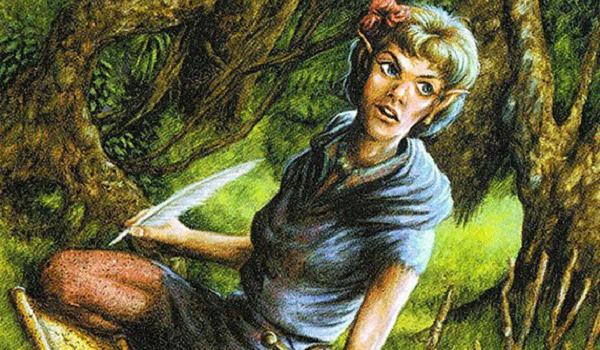
To that end, I'll be picking up where I left off two weeks ago with Modern Horizons 2 speculation. There's no way to predict what new cards may come, but I could discuss the cards I'd like to see reprinted. However, I won't just belch out a list of cards and be done with it. I've got standards, after all. I set down rules in the first article, and I'll stick to them:
- Don't make Modern into Legacy. Reasonable power levels and it has to make sense in Modern's context.
- No hate cards. It's too easy/lazy, and also boring. I have to pick cards that encourage brewing and new gameplay.
- No low-hanging fruit. Counterspell is obviously ok for Modern; I'll look deeper and push myself to find hidden gems.
I led off with white and blue, so today I'll be working through the Jund colors. And they were tougher than expected.
Tainted Pact
Every time someone brings up possible Legacy imports, it seems like black gets the most unreasonable suggestions. Why, oh why, do players think Hymn to Tourach is ok? I thought everyone wanted to play Magic, not randomly ruin someone's day. However, that might be a function of players seeing black as the color of discard and removal more than anything else. Understandable, really, since that is a significant part of what black does these days. What they forget is that black is also about the high-risk, high-reward cards, and that's why my pick is Tainted Pact.
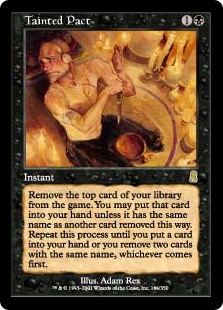 I have very fond memories of Pact from when I was learning to play. The store owner at my first FNM played in the tournament, and was playing Odyssey mono-black control, but ran Pact rather than Demonic Tutor. He may have also had legitimate curve or metagame reasons for doing so, but he definitely kept running Pact because it was fun. Every time he cast Pact, it was a whole production, and for a kid just learning the game, it was awesome to watch. He'd go on like a carnival barker about spinning the wheel of fate, and it never failed to lighten the mood and make the whole store feel fun. This singular experience was largely responsible for drawing me into Magic.
I have very fond memories of Pact from when I was learning to play. The store owner at my first FNM played in the tournament, and was playing Odyssey mono-black control, but ran Pact rather than Demonic Tutor. He may have also had legitimate curve or metagame reasons for doing so, but he definitely kept running Pact because it was fun. Every time he cast Pact, it was a whole production, and for a kid just learning the game, it was awesome to watch. He'd go on like a carnival barker about spinning the wheel of fate, and it never failed to lighten the mood and make the whole store feel fun. This singular experience was largely responsible for drawing me into Magic.
Unlike every other Demonic Consultation variant I can think of, Tainted Pact doesn't guarantee finding a specific card. It just digs into the deck, and you select a random one. The beauty and the balance is that if two of the same card are ever revealed, you get nothing, hence the carnival associations. Pact is an elaborate cantrip that rewards certain deckbuilding choices as well as its caster's understanding of probability. And I'm all about skill-testing cards and encouraging players to branch out in their deckbuilding.
Potential Utility
Also unlike every other Demonic Consultation variant that I can think of, Pact isn't a clear candidate for combo abuse. Outside of some extreme Lutri, the Spellchaser-related shenaniganry, Pact can never exile an entire library à la Spoils of the Vault (no combo with Thassa's Oracle). The fairest use of Spoils I've ever seen was in Esper Death's Shadow back in 2017, where the guy was using it to get a turn 2 Shadow. And instead killed himself two times against me. Otherwise, it's just been used to find Ad Nauseam as far as I know. Pact also 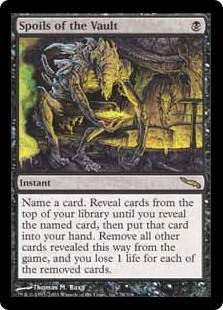 doesn't cause loss of life, so it doesn't synergize with Death's Shadow. Plus, even as just a cog in a combo deck, it can't really search for a critical combo piece any better than a normal cantrip. Which will limit Pact's usage to fairer decks.
doesn't cause loss of life, so it doesn't synergize with Death's Shadow. Plus, even as just a cog in a combo deck, it can't really search for a critical combo piece any better than a normal cantrip. Which will limit Pact's usage to fairer decks.
And that's where the really interesting part lies. I'm not sure what kind of deck would use Pact. I don't think the deck that could use Pact currently exists. Jund-style midrange doesn't need a two-mana cantrip, and there's no black control. An aggressive deck might be risky since they tend to have more four-of's than control, but also run fewer lands. The deck that wants Pact runs a wide range of spells with each one in small numbers, doesn't run many playsets of lands, doesn't mind exiling cards from its library, and is based in black. The 4-Color Omnath decks fit the first two categories, but not the last two, which may open up space for something new. Control players like digging into their decks and generally have some redundancy, so it makes sense for something new to arise and take advantage of Pact.
The Risk
As noted, the odds are pretty low for Pact to suddenly break Modern. I can't even say that Pact is much of a consistency tool, since the outcome is pretty random. There's few ways to stack the top of your library in Modern, so the risk of hitting a duplicate card rises quickly the deeper Pact goes. It's just a slightly odd cantrip, and so I'd say the risk is pretty low.
Likelihood
Wizards isn't exactly fond of Consultation-style cards. I seriously can't think of a variant since Spoils, and couldn't find one after trying. However, Pact is so different from the other options that Wizards might be willing to try again. It doesn't have the same risks as Consultation or Spoils and doesn't see Legacy play, so I'd call Pact a plausible inclusion.
Blood Oath
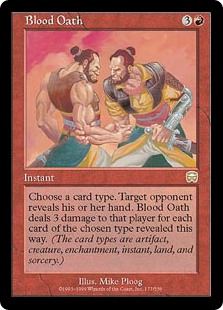 Red was really hard. For most of Magic's history, red was the color of four things: Land hate, burn, goblins, and janky enchantments. And while I'd love to really punish Uro decks with Price of Progress, it violates rule 2. And may not be healthy for Modern anyway. Modern already has most of the good burn, and Flame Rift is too good with Death's Shadow and Scourge of the Skyclaves. Most of the good-but-not-busted goblins are in Modern already. And jank is jank. I really had to dig deep and remember an obscure card that Extended players often discussed in hushed tones when I was starting out.
Red was really hard. For most of Magic's history, red was the color of four things: Land hate, burn, goblins, and janky enchantments. And while I'd love to really punish Uro decks with Price of Progress, it violates rule 2. And may not be healthy for Modern anyway. Modern already has most of the good burn, and Flame Rift is too good with Death's Shadow and Scourge of the Skyclaves. Most of the good-but-not-busted goblins are in Modern already. And jank is jank. I really had to dig deep and remember an obscure card that Extended players often discussed in hushed tones when I was starting out.
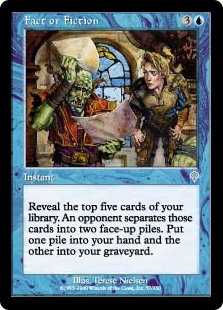 Blood Oath is a very strange card. It's straightforward to play, but the threat of it makes opponents play strangely. I heard a story somewhere that during a GP one player split a Fact or Fiction pile of five instants 5-0. Their opponent, being tapped out, saw that said player had four mana open and was playing red. Suspicious of a lethal Blood Oath, the pile of zero was selected. In something of a reversal of my list so far, Oath is an excellent card against slower decks, but not in them. Aggro decks empty their hands quickly, reducing Oath's effectiveness, but would love to punish those who hold cards.
Blood Oath is a very strange card. It's straightforward to play, but the threat of it makes opponents play strangely. I heard a story somewhere that during a GP one player split a Fact or Fiction pile of five instants 5-0. Their opponent, being tapped out, saw that said player had four mana open and was playing red. Suspicious of a lethal Blood Oath, the pile of zero was selected. In something of a reversal of my list so far, Oath is an excellent card against slower decks, but not in them. Aggro decks empty their hands quickly, reducing Oath's effectiveness, but would love to punish those who hold cards.
At the same time, Oath is very much a precision tool. It takes a lot of format and deck knowledge to know what to card type to name. Again, I like skill-testing cards, particularly ones that show off how much more knowledgeable you are, and this Oath would benefit from the Modern we currently have.
Potential Utility
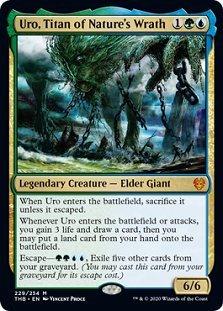 Obviously, Oath is meant to punish slow control decks that hold cards in hand. It's theoretically possible that it hammers Afterlife from the Loam decks too, but that's far less likely. In a Modern where grindy value and card accumulation are at an all-time high, Oath would be particularly potent. There's nothing as satisfying as really punishing a durdly deck for tapping out. However, Oath could never be too punishing thanks to planeswalkers taking up a lot of slots that would have gone to sorceries or instants back when it was first printed. The number of card types being greater reduces Oath's impact by making it harder to guess an opponent's hand. Oath would be a threat, but not necessarily a lethal one.
Obviously, Oath is meant to punish slow control decks that hold cards in hand. It's theoretically possible that it hammers Afterlife from the Loam decks too, but that's far less likely. In a Modern where grindy value and card accumulation are at an all-time high, Oath would be particularly potent. There's nothing as satisfying as really punishing a durdly deck for tapping out. However, Oath could never be too punishing thanks to planeswalkers taking up a lot of slots that would have gone to sorceries or instants back when it was first printed. The number of card types being greater reduces Oath's impact by making it harder to guess an opponent's hand. Oath would be a threat, but not necessarily a lethal one.
There's additional utility besides attacking midrange and control decks. Combo decks are a great target. Ad Nauseam and Storm style decks are particularly attractive, as they need a critical mass of spells in hand, and those tend to be all instants. An upkeep Oath on the combo turn against Storm sounds like a devastating move. Granted, right now Oops, All Spells is the main combo deck, but it is still weaker than you might think to Oath.
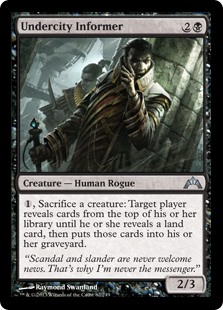 Oops doesn't need a critical mass to go off, just one specific card, so it can't be effectively punished for resource accumulation. However, because Oops has no lands, the Oath call is easier. This is especially the case since Oops is typically 1/3 creatures and 1/3 sorceries. In that matchup, Oath is less of a guessing game than most, and provides an opportunity to really punish a slow combo. Being four mana means that Oath can't really preempt the combos, which incentivizes decks that might want to Oath to have additional disruption.
Oops doesn't need a critical mass to go off, just one specific card, so it can't be effectively punished for resource accumulation. However, because Oops has no lands, the Oath call is easier. This is especially the case since Oops is typically 1/3 creatures and 1/3 sorceries. In that matchup, Oath is less of a guessing game than most, and provides an opportunity to really punish a slow combo. Being four mana means that Oath can't really preempt the combos, which incentivizes decks that might want to Oath to have additional disruption.
Oath is not very effective in an aggro matchup. While these decks tend to be very creature-heavy, giving Oath the chance to deal massive damage, they also dump their hands, and Oath costs four mana.
The Risk
The risks of a four-mana instant are naturally low due to Modern's speed. The format can also easily adapt to Oath by changing up deck composition or prioritizing casting their spells rather than sitting on counters.
However, there is a risk of Oath being very punishing alongside other information-gathering cards. If Gitaxian Probe wasn't rightly banned, I could see Oath being too effective. As is, Oath doesn't exactly synergize with Thoughtseize, since discard reduces the targets for Oath. It doesn't necessarily conflict either, since information is still information, and the Oath player can just track how the hand has changed and make reasonable conjectures. Therefore, there is a risk of Oath being a bit too reliable outside its intended use.
Likelihood
This is a very reprintable card. Red gets to deal damage based on opposing permanent types (see Aura Barbs, Cindervines, and Enchanter's Bane), and punisher-type cards get printed all the time. The questions is whether Wizards is ok with red doing that to cards in hand, and Rosewater is pretty quiet on that front. I'd say Blood Oath is plausible.
Quirion Ranger
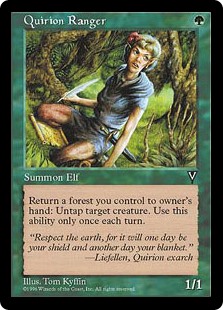 I had a problem with green, too. A lot of green's good cards from early Magic are ramp spells or mana generators, and Modern definitely doesn't need more of that. Outside that there is lots of artifact destruction and fatties, but those aren't unique or interesting. Sylvan Library is a color-pie break, so it's not happening (and really, does green need more card advantage now?). A lot of other interesting cards don't really make sense in Modern or are pretty busted, like Carpet of Flowers, Natural Order, and Crop Rotation.
I had a problem with green, too. A lot of green's good cards from early Magic are ramp spells or mana generators, and Modern definitely doesn't need more of that. Outside that there is lots of artifact destruction and fatties, but those aren't unique or interesting. Sylvan Library is a color-pie break, so it's not happening (and really, does green need more card advantage now?). A lot of other interesting cards don't really make sense in Modern or are pretty busted, like Carpet of Flowers, Natural Order, and Crop Rotation.
This pushed me towards that other green mine, Elves. Many of the best ones are already in Modern or are mana engines, and Elves doesn't need more of that. It came down to Wirewood Symbiote or Quirion Ranger, and I picked Ranger. Symbiote functions too much like ablative armor, which exacerbates Elves's grindy nature. Legacy Elves is a combo deck, but 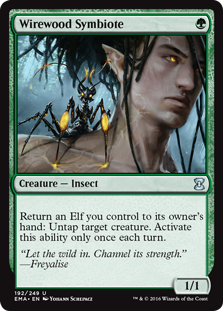 Modern's version is decidedly tribal beatdown, often so filled with 2-for-1's and Collected Company that it's hard to keep up outside sweepers. Symbiote would be another bit of grind, and just adding another tool isn't what I'm looking for.
Modern's version is decidedly tribal beatdown, often so filled with 2-for-1's and Collected Company that it's hard to keep up outside sweepers. Symbiote would be another bit of grind, and just adding another tool isn't what I'm looking for.
Ranger is more unique. It trades long-term land development for immediate mana boosting, being a sort of engine despite not actually producing mana. The implications of bouncing a forest are interesting to contemplate, as is actually building a deck to utilize the temporary boost effectively. Again, Symbiote just fits. Plus, Ranger hasn't actually seen a printing since Visions. Not a big price problem for a common, admittedly, but still, it's about time.
Potential Utility
Elves can just slot in Ranger, but to really maximize it will take some major readjustments. Legacy Elves uses Ranger to cheat on lands while gaining mana from Dryad Arbor, which isn't played in Modern. It also untaps elves for additional Heritage Druid activations. The most obviously good use for Ranger in Modern is untapping Dionus, Elvish Archdruid, which isn't bad, but is hardly the same as accelerating into Natural Order. Does Modern Elves want to go more land-light and cheat drops using Ranger? I don't know, but it would be interesting to find out.
Additionally, maybe there are decks outside Elves that want to replay their forests. I can't think of any, but the option is there. Amulet Titan likes to bounce lands, but those are Simic Growth Chambers. Unless Field of the Dead or Valakut, the Molten Pinnacle want some insurance to hit their triggers.
The Risk
 It's a 1/1 elf. Everything kills it, and the risk/reward in its ability makes removal an even more punishing possibility. While there is some chance that Ranger proves an unexpected mana boost and something breaks, it would be easy enough for the format to adapt and clean up the mess.
It's a 1/1 elf. Everything kills it, and the risk/reward in its ability makes removal an even more punishing possibility. While there is some chance that Ranger proves an unexpected mana boost and something breaks, it would be easy enough for the format to adapt and clean up the mess.
Likelihood
Wizards doesn't like to just include cards in sets so they can be reprinted, so Ranger would need to fit into a draft theme. Landfall is very popular and we just went back to Zendikar, so if there was ever a time to finally reprint this Legacy staple, Horizons is it. I think it pretty likely.
Speculative Fiction
And that concludes the mono-colored cards. I'll wrap this series up next week with the multicolored card, the artifact, and the land. I'll see you then.




Haha, it’s like the comments on the first part precipitated the second because there were some pretty incoherent picks, like some/any of the mirage block tutors and various cards that have been enabled gross/iffy business over the last thirty years.
I don’t have the reserved list memorized, so maybe some/all of these are on it, but:
Tithe, Rising Waters and Plague Spitter(maybe downshifting the latter’s rarity too hehe).
Silver Knight would be pretty cool.
Eternal Dragon seems incredibly safe—maybe a updated eternal dragon? 3WW for a 3/5 instead and 2W to return it, during upkeep?
Saltiness about how fond the r&d team is of giving all-the-colours decks new toys notwithstanding, they did a pretty good job with reinventing old school fun-police cards with the first Modern Horizons, so the second will probably not disappoint. Force of Negation was pure genius…seriously. Such a great addition to the format.
Just one card that’s half as excellent and I’d be happy.
I know how it looks, but rest assured I had my list together well before the first article.
Tithe is reserved list, unfortunately, or I’d have gone for it over Land Tax. Funnily enough, Aaron Forsythe initially put Tithe into 9th Edition because he didn’t know it was reserved either. It’s why we got Gift of Estates instead.
I think crop rotation would be…interesting in Modern. Without Dark Depths, without Cloudpost, without Tabernacle, I don’t think it would break the format in half or anything. I’m not sure if any of the Field of the Dead/Prime Time decks would run it because they already don’t have issues finding the lands they need between Titan, Reclaimer, Tolarian West, Hour of Promise, and Scapeshift (depending on what exact deck it is). That leaves green Tron as the main beneficiary, giving them another way to assemble Tron. Well, I guess Infect too maybe…being able to run up to 8 copies of Inkmoth Nexus seems like something they’d be in the market for, similar to legacy Infect. But…I feel like Tron and Infect especially aren’t really tearing it up in Modern right now, so I don’t know.
Now as far as red cards, what do people think about Pyrokinesis? It can be a free-ish instant speed sweeper, but requires a heavy red commitment, which tends to be fulfilled mainly by the sorts of decks that *aren’t* interested in that sort of effect.
Crop Rotation is one of those that’s definitely a lot worse in Modern than Legacy, but I’m not sure it’s ok. Any instant speed tutor is potentially very dangerous, and given that it’s one mana there’s potential for something busted to happen. Or at least some absurd value from Flagstones of Trokair.
It’s actually not that hard to make Pyrokinesis absurdly powerful, thanks to all the card drawing red’s gotten recently. Legacy Goblins uses it as a creature match breaker and it is devastating there. I’m not a fan of a manaless sweeper.
Yea, Crop Rotation being an instant is a little bit busted, I will agree. What do you think about them putting in some of the core cards from legacy enchantress? Stuff like Sterling Grove, Argothian Enchantress, Enchantress’ Presence, Wild Growth, etc.? I feel like those would all be relatively safe, as other than Wild Growth, I don’t see a current deck that wants those cards. Those are probably the safest kind of reprints IMO, the ones that expand the *potential* pool of playable decks, rather than just boost pre-existing ones.
Without Elephant Grass and more importantly Serra’s Sanctum, Legacy Enchantress couldn’t be a thing in Modern. That doesn’t necessarily make a lot of the core enchantments ok (Enduring Ideal is absolutely infuriating to play against) but the Enchantress’ themselves might be ok.